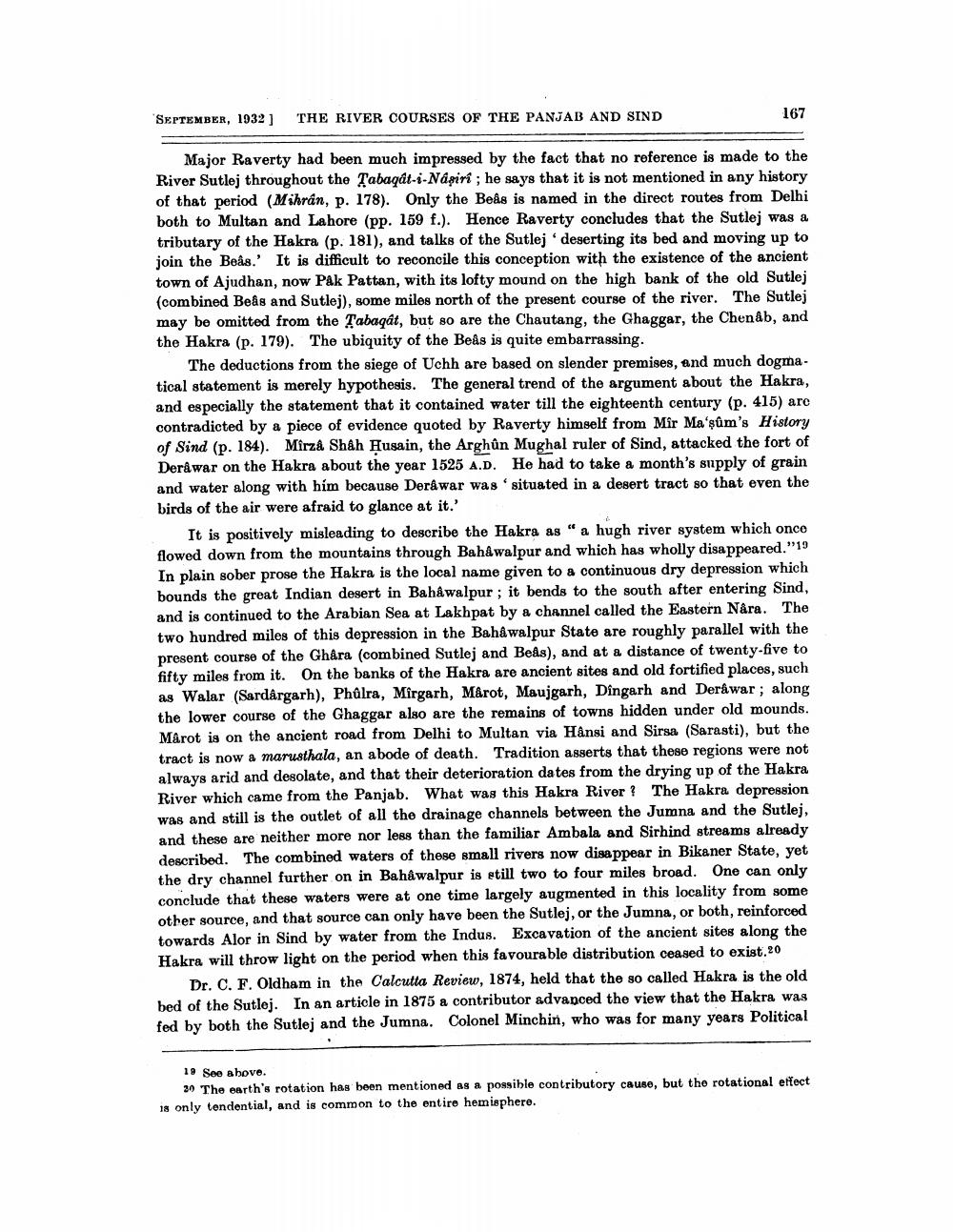________________
SEPTEMBER, 1932)
THE RIVER COURSES OF THE PANJAB AND SIND
167
Major Raverty had been much impressed by the fact that no reference is made to the River Sutlej throughout the Tabaqát--Napiri ; he says that it is not mentioned in any history of that period (Mihran, p. 178). Only the Beas is named in the direct routes from Delhi both to Multan and Lahore (pp. 159 f.). Hence Raverty concludes that the Sutlej was a tributary of the Hakra (p. 181), and talks of the Sutlej 'deserting its bed and moving up to join the Beas.' It is difficult to reconcile this conception with the existence of the ancient town of Ajudhan, now Pak Pattan, with its lofty mound on the high bank of the old Sutlej (combined Beas and Sutlej), some miles north of the present course of the river. The Sutlej may be omitted from the Tabagát, but so are the Chautang, the Ghaggar, the Chenab, and the Hakra (p. 179). The ubiquity of the Beas is quite embarrassing.
The deductions from the siege of Uchh are based on slender premises, and much dogmatical statement is merely hypothesis. The general trend of the argument about the Hakra, and especially the statement that it contained water till the eighteenth century (p. 415) are contradicted by a piece of evidence quoted by Raverty himself from Mir Ma'sum's History of Sind (p. 184). Mirza Shah Husain, the Arghûn Mughal ruler of Sind, attacked the fort of Deråwar on the Hakra about the year 1525 A.D. He had to take a month's supply of grain and water along with him because Derawar was ' situated in a desert tract so that even the birds of the air were afraid to glance at it.'
It is positively misleading to describe the Hakra as "a hugh river system which once flowed down from the mountains through Bahawalpur and which has wholly disappeared."19 In plain sober prose the Hakra is the local name given to a continuous dry depression which bounds the great Indian desert in Bahâwalpur ; it bends to the south after entering Sind, and is continued to the Arabian Sea at Lakhpat by a channel called the Eastern Nära. The two hundred miles of this depression in the Bahawalpur State are roughly parallel with the present course of the Ghåra (combined Sutlej and Beds), and at a distance of twenty-five to fifty miles from it. On the banks of the Hakra are ancient sites and old fortified places, such as Walar (Sardárgarh), Phúlra, Mirgarh, Mårot, Maujgarh, Dingarh and Derawar; along the lower course of the Ghaggar also are the remains of towns hidden under old mounds. Mârot is on the ancient road from Delhi to Multan via Hansi and Sirsa (Sarasti), but the tract is now a marusthala, an abode of death. Tradition asserts that these regions were not always arid and desolate, and that their deterioration dates from the drying up of the Hakra River which came from the Panjab. What was this Hakra River? The Hakra depression was and still is the outlet of all the drainage channels between the Jumna and the Sutlej, and these are neither more nor less than the familiar Ambala and Sirhind streams already described. The combined waters of these small rivers now disappear in Bikaner State, yet the dry channel further on in Bahawalpur is still two to four miles broad. One can only conclude that these waters were at one time largely augmented in this locality from some other source, and that source can only have been the Sutlej, or the Jumna, or both, reinforced towards Alor in Sind by water from the Indus. Excavation of the ancient sites along the Hakra will throw light on the period when this favourable distribution ceased to exist.20
Dr. O. F. Oldham in the Calcutta Review, 1874, held that the so called Hakra is the old bed of the Sutlej. In an article in 1875 a contributor advanced the view that the Hakra was fed by both the Sutlej and the Jumna. Colonel Minchin, who was for many years Political
19 See above.
39 The earth's rotation has been mentioned as a possible contributory cause, but the rotational effect 18 only tendential, and is common to the entire hemisphere.




